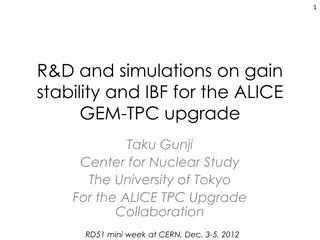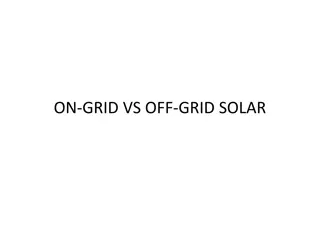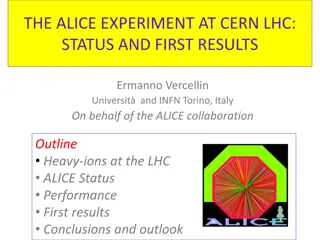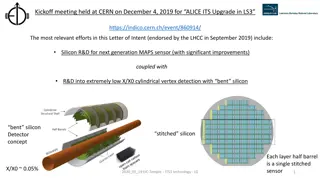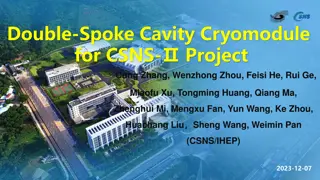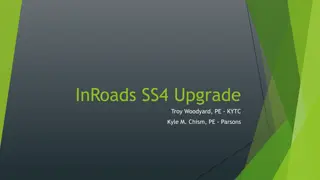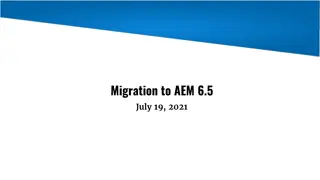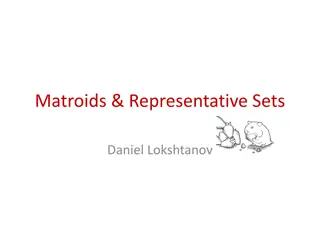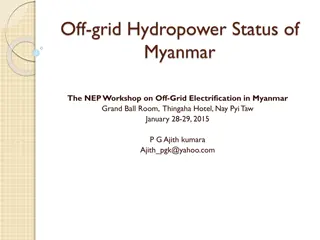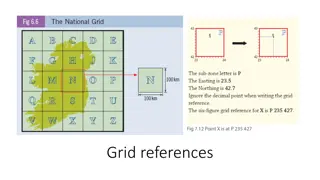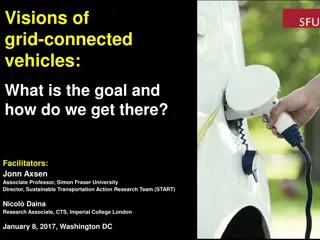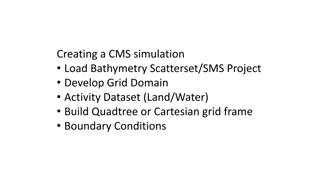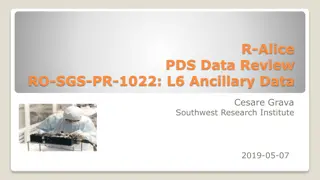Concept for ALICE Upgrade: Gating Grid by Howard Wieman
The Technical Design Report outlines a plan to use GEM detectors for the TPC readout in ALICE upgrade, addressing issues with positive ion back flow. A modified gating grid design is proposed to block 100% of the back flow while maintaining data rate. The concept involves specific parameters and operational details for effective implementation.
Uploaded on Sep 14, 2024 | 0 Views
Download Presentation

Please find below an Image/Link to download the presentation.
The content on the website is provided AS IS for your information and personal use only. It may not be sold, licensed, or shared on other websites without obtaining consent from the author. Download presentation by click this link. If you encounter any issues during the download, it is possible that the publisher has removed the file from their server.
E N D
Presentation Transcript
gating grid concept for ALICE upgrade Howard Wieman 4/2/2014 4/2/2014 1
The Technical Design Report for the TPC Upgrade of the ALICE Time Projection Chamber outlines a plan to use GEM detectors for the TPC readout in which there is an estimated positive ion back flow into the drift volume which is 1% of the 2000 gas gain. This positive ion source was estimated to be 40 times[1] the primary ionization and was estimated to cause up to 20 cm distortions of the electron drift path[2]. The assumed ion species used for the distortion estimation are not those with the lowest ionization potential so the space charge could be composed of possibly slower ions[5] in which case still larger distortions would be generated. Given the difficulty of dealing with large distortions and the uncertainty in their amplitude a gating grid would be a reasonable consideration. As stated in the report the anticipated 50 kHz trigger rate precludes using a gating grid of the conventional form that has been used for PEP4, STAR, ALICE, ALEPH and others[3]. However, a modified gating grid design would work. Outlined in the following is a concept for a gating grid that could be used for the ALICE upgrade which would block 100% of the positive ion back flow from the gain region while still utilizing 75% or more of the full luminosity data rate. See following diagram, discussion of operation and table of operating parameters: 4/2/2014 2
gating grid wires field cage cathode Lg = 12 mm w = 2 mm avalanche region secondary positive ion source Eopen Eclose Edrift Le = 250 mm 4/2/2014 3
ion capture drift field, grid closed Parameter definitions with example values Ec Lg KI Eo To = Lg/KI Eo w 2000 V/cm ref gating grid channel length 12 mm 7 cm2/V sec Ion mobility, CO2+ in Ne drift field in open grid, same as in TPC drift volume 6 400 V/cm 4 time gate is open 429 s gating grid channel width 2 mm Ec capture field, gate closed 2000 V/cm 4/2/2014 4
ref Ec Tc = w/KI Ec Tp = To+Tc freq = 1/Tp duty cycle ion capture drift field, grid closed 2000 V/cm time gate is closed, ion capture time 14 s gating grid drive period 443 s gating grid drive frequency 2.3 kHz gating grid drive duty cycle 3 % Le ve Te = Le/ve Ta = To - Te TPC drift length 250 cm 4 electron drift velocity 2.58 cm/ s 4 electron transit time in TPC drift volume 97 s 4 TPC active time, receiving triggers 332 s TPC live time fraction for this example. 4/2/2014 5
wave form for gating grid example positive ion clearing time electron transit time in TPC 97 s 14 s 332 s closed open TPC active, green envelope 443 s positive ion transit time in gating grid channel Increasing the gating grid channel length or reducing the positive ion velocity increases the active fraction since the wait for the last event electron transit time constitutes a smaller fraction of the total period. See active fraction dependence on gating grid channel length in the following slide: 4/2/2014 6
Fraction of TPC live time as a function of the length of the gating grid channel. A 30 mm channel length gives a live time of 90 %. 4/2/2014 7
Conclusion A relative straight forward gating grid system could provide 100 % exclusion of the back flow positive ions in the drift volume. This provides a factor of 40 reduction in the space charge distortion from what is estimated in the ALICE upgrades proposal with a very minor loss in data collection time. A loss of 25 % would soon be made up for as the luminosity from the LHC increases beyond the design goal. Currently there is large uncertainty in the positive ion species and consequently the space charge distortion could by significantly larger than what is estimated in the upgrades proposal. The gating grid would provide insurance against this potential problem. If 25 % data loss is unacceptable then the grid design can be easily modified to provide only 10 % loss in data collection time. Note: The concept is illustrated here with a stack of grid wires, i.e. a stack of conventional gating grids. However, it may be mechanically more straight forward to use a stack of foil mesh grids using the same technology that was developed to stretch and mount the GEM foils. The ion collection fields would then be parallel to the normal drift field but would reverse direction at each foil crossing. 4/2/2014 8
References 1. ALICE Collaboration, Technical Design Report for the Upgrade of the ALICE Time Projection Chamber, ALICE-TDR-016, March 3, 2014, p. 86-88. 2. Ibid., p. ii 3. Ibid., p. i, 2 4. Ibid., p. 6, Table 1.1 5. W. Blum and L. Rolandi, Particle Detection with Drift Chambers, Springer-Verlag, 1994, p. 62-65. Earl W. McDaniel and Edward A. Mason, The Mobility and Diffusion of Ions in Gases, John Wiley & Sons, 1973, p. 10,29,39,40. In the STAR experiment the required correction for space charge distortion is 3 times (Gene Van Buren private communication) the predicted space charge density http://www- rnc.lbl.gov/~wieman/TPC%20Rev%202006%20abrv%20for%20Ron.pdf (H. Wieman). This could be due to charge transfer to slower unidentified contaminants. 6. R. Veenhof, Calculations for the Alice TPC read-out http://rjd.home.cern.ch/rjd/Alice/neon_mobility.html. S. Rossegger, J. Thomas, Space-charge effects in the ALICE TPC: a comparison between expected ALICE performance and current results from the STAR TPC, Internal Note/ ALICE-INT-2010-017 version 1.0. H.W. Ellis and E.W. McDaniel, D.L. Albritton, L.A. Viehland, L.L. Lin and E.A. Mason, Transport Properties of Gaseous Ions Over a Wide Energy Range. Part II, Atomic Data and Nuclear Data Tables 22, 179-217 (1978). Original source: T. Koizumi, N. Kobayashi, and Y. Kaneko, J. Phys. Soc. Japan 43, 1817 (1977) This data only goes down to a field of 2000 V/cm, but this is still in the low field region, i.e. ion energies are thermal, so it should be reasonably accurate for the range considered in this example using 400 V/cm. 4/2/2014 9
4/2/2014 10
4/2/2014 11
200 m gating grid wires 200 volts on grid drift field 400 V/cm positive ions inside the last wire plane are trapped ions outside the last plane leak max z starts 12 mm max z starts 13 mm 4/2/2014 12
mean flush time 23 s the straggler 4/2/2014 13
Gene Van Burens checker board bias mean 28 s 4/2/2014 14



